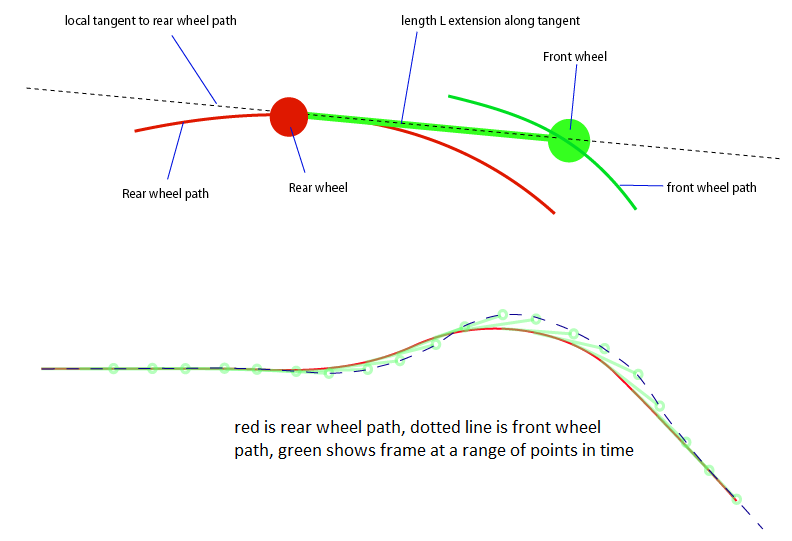We can gain some insight into this relation if we note that the velocity vector of the rear wheel must be at every instant proportional to the vector pointing along the body of the bike itself:
$$ \dot{\vec{R}}=\frac{\vec{F}-\vec{R}}{\left|\left|\vec{F}-\vec{R}\right|\right|}v_{\small R} \ , \tag{1}$$
where $v_{\small R}$ will have units of speed, as it is multiplied by a unit vector which is always dimensionless.
Now this allows us to also express $\vec{R}$ in terms of $\vec{F}$, which I think is what you are aiming for in your question:
$$ \vec{R} = \vec{F}-\frac{L}{v_{\small R}}\dot{\vec{R}}\ , \tag{2}$$
where I've substituted $\left|\left|\vec{F}-\vec{R}\right|\right| = L$.
Now, to see an example of how steering, i.e. setting $\vec{F}$ to be a certain curve affects the trajectory of the back wheel position $\vec{R}$, we need to choose some explicit curve for $\vec{F}$. For example, let's introduce some coordinates and let $\vec{F}$ move in a circular trajectory a distance $r_0$ from the origin:
$$ \vec{F} = r_{\small 0}(\cos\omega t\ \hat{x} + \sin\omega t\ \hat{y}) $$
So that using $(2)$ to solve for $\vec{R}$, we get a couple of differential equations:
$$ R_x(t) = r_{\small 0}\cos\omega t - \frac{L}{v_{\small R}} \dot{R_x}(t) $$
$$ R_y(t) = r_{\small 0}\sin\omega t - \frac{L}{v_{\small R}} \dot{R_y}(t) $$
There is more than one possible solution, let's focus on one of the simpler ones that doesn't involve an exponential:
$$ \vec{R} = \frac{r_0 v_{\small R}}{\omega^2 L^2 + v_{\small R}^2}\left[\left( \omega L\sin\omega t + v_{\small R} \cos\omega t \right)\hat{x}+ \left(-\omega L\cos\omega t + v_{\small R} \sin\omega t\right) \hat{y}\right],$$
and applying the normalization condition implied by $(1)$, that $\Big|\Big|\dot{\vec{R}}\Big|\Big| = v_{\small R}$ we also find that the angular frequency $\omega$ must satisfy:
$$ \omega = \frac{v_{\small R}}{\sqrt{r_0^2-L^2}}. $$
I've checked via Geogebra if this gives a sensible result, here is an example capture of what I got:

The green track represents the front wheel, the red the back one. You can also interact with this demonstration here.
Despite clearly being a toy model, I think this is what you'd reasonably expect. For example try setting $r_0$ to the possible minimum (which I've limited to be always slightly more than $L$). In that case, the situation corresponds to spinning the bike around itself, with the back wheel remaining nearly stationary. So at least this, as a "sanity check", seems to correspond to what you'd observe in reality. Hope this helps!
An added note, to respond to your remark that this is an implicit model, and hence seems to be less useful in getting a feel for the underlying physics/dynamics. I was also slightly surprised at first, and expected it to be different.
Then I realized, the nice thing about expressing the relation that way is that it makes the minimum possible assumptions about the path that the bicycle can take. It only uses a very simple geometrical fact, which as pointed out by @ThePhoton here, is more a consequence of geometry than of dynamics/kinematics.
This is powerful because, it's a great starting point from which to begin investigating any concrete example, like the very simple one I presented here. We could make a model that introduces two different direction vectors, one that the front steering wheel is pointing along, call it $\hat{n}_{\small F}$, and a second one which is always parallel to the bicycle, $\hat{n}_{\small B}$, but then we would have a much more complicated equation involving both these vectors, and implicitly that means also the angles they make with respect to each other, which is also dependent on time of course.
Now, I'm not saying that couldn't be useful too. There are many ways to model a system. I am only stressing that it is in fact a theme in physics to find the simplest, daresay most abstract, relations first, and then add any complexity on top of that. It would inevitably mean that our starting point is more "implicit" as you say, but it also means it is very general, hence it makes for a good foundation for further development, and for the exploration of any concrete physical situation.
Recommended reference:
Bor, Gil & Levi, Mark & Perline, Ron & Tabachnikov, Serge. (2017). Tire track geometry and integrable curve evolution. 10.48550/arXiv.1705.06314.






